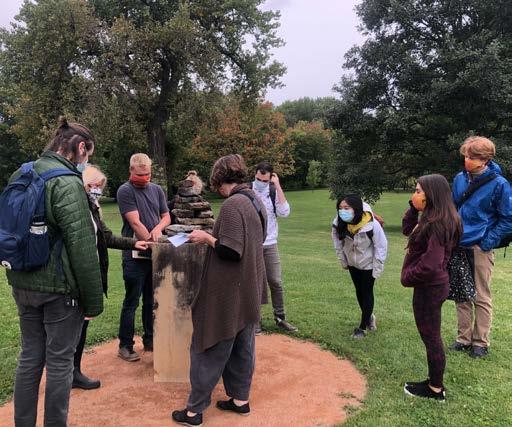
3 minute read
Celebrating the River
Rare Mississippi River Drawdown
In early October of 2020 thousands of people gathered at the Mississippi River in downtown Minneapolis during a rare drawdown of the pool just below St. Anthony Falls.
Advertisement
For those who were able to check it out, a glimpse of a less-engineered Mississippi River was available in Minneapolis, when the U.S. Army Corps of Engineers lowered water levels below St. Anthony Falls by 12 feet. People explored the river floor, temporarily visible under the Stone Arch Bridge, and enjoyed a much closer experience to river wildlife and other hidden mysteries.
Thousands of visitors were climbing down the river bank to see the exposed bridge footings, the exposed foot of St. Anthony Falls and historic remains of old river structures normally covered by the Mississippi River waters. In addition to the resurfaced historic infrastructure, visitors also came to see the debris that had been dropped in the river over the years.
Access to the river is steep and hazardous, but this poor access didn’t stop people from visiting this rare glimpse into what a free flowing River Gorge would look like. If the dams were to be removed completely, this would become the norm, and the water would actually drop even further in the late summer months, potentially drawing visitors annually to see the spectacle of the river.

Seasonal Drawdown Event
In the late summer months, the river historically would drop to extremely shallow depths, and if dams were to be removed this would again happen annually. I propose a yearly event where people come to learn about and enjoy the river, taking advantage of the extended shorelines and exposed ruins.
With seasonal low water levels people could explore even more of the hidden infrastructure and dam ruins. Kayakers could take advantage of the ephemeral rapids, and experienced guides could lead people across shallow stretches of the river like many did historically. People from Saint Paul and Minneapols will drag LED lit buoys across the river, bounding the space to admire the Mississippi River Garden.
Exploring Ruins Learning About Storm water Infrastructure + Hydrology


Minneapolis St. Paul
Site Axonometric


Kayak and Recreation Relays Buoys at Night


Concluding Thoughts
The Fall 2020 semester has been one for the books. It is truly a time of culminating crisis. An ongoing pandemic and increasing civil unrest paired with virtual design school was certainly a challenge for all of us. With that said, I couldn’t have asked for a better studio to be a part of.
We learned so much about what it means to be a human in this world, and I believe gardens are a place of total human expression. They are places for seeing the world in new an unconventional ways, and places that can make people truly feel pain, joy, and everything in between.
We need these places to feel, and it is our job as designers to bring them into the world or reveal them. Emotion drives change, and if we can empower people to feel, then we empower change. I really appreciated a studio that allowed me to feel and to ponder big questions that often arn’t talked about openly in the world of Landscape Architecture. I never felt like I had to do one specific thing, as long as I wrote, sketched, or ruminated. I always felt safe to just keep digging, keep asking questions, and to learn from my peers about what it means to make gardens of emotion.
That doesn’t mean that this studio was easy; in fact, it was a real challenge. It is not easy to design around emotions, but it is so rewarding and eye opening to try. I will take what I’ve learned in this studio with me as I move forward into my final semester in the UMN MLA program and into my career. I know there is always a place for emotion in design, and now I find it important to advocate for it. It is our role as designers to help people to feel and to see the world in new ways. Peace out fellow studio explorers, and keep slogging!







